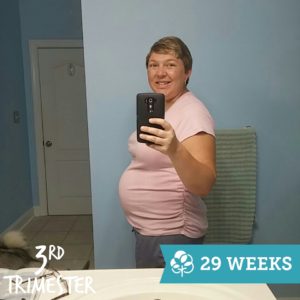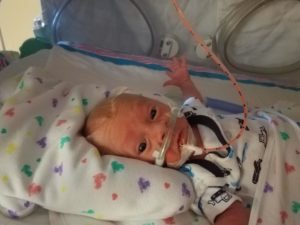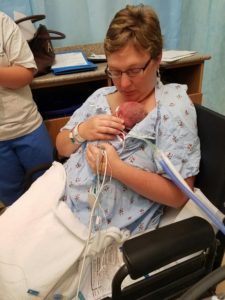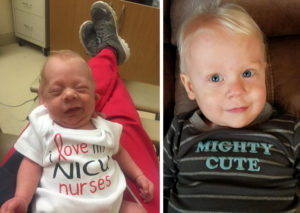During Nurses Week, we honor the hard work and dedication required of every nurse. The long hours and challenging shifts can wreak havoc on the body and mind. Many nurses live in a chronic state of stress, which can manifest through headaches, insomnia, decreased immunity, hypertension, and risk for heart disease. Here are a few ways to incorporate wellness into your daily life.
Create a Routine
By establishing a wellness routine, you’ll be more likely to stick with it. Any of the following little tips can easily be added to your day—it’s not all or nothing! Most will take just a few minutes, and some can be incorporated during your commute to work. Creating a wellness routine only requires a commitment from you to take better care of yourself.
Just Breathe
The act of conscious, deep breathing can actually change your mood from tired, anxious, and unnerved to energized and calm in virtually no time. Sit tall, draw your shoulders back and down, and lengthen through the crown of your head. Eyes opened or closed, begin breathing deeply in and out through the nose. Take about 20 rounds of breath and notice how you feel.
Make a Mantra
This could be something as simple as “I am enough” or even “It’s going to be a great day.” Your mantra could even be a single word such as “peace” or “serenity.” Write it on your mirror, put it on a Post-It, say it when you first wake up or when you’re feeling stressed. There are several studies that suggest that having a personal mantra allows you to reduce stress and anxiety naturally.
Fall in Love with Lavender
Studies have shown that lavender can help with stress, depression, and anxiety. Buy pure, organic essential oil at your local health food store. Diffuse it in your home, or put three to four drops on a tissue and keep it in your car console so you can get a few whiffs during your pre-shift deep breathing. You might even consider dabbing a drop or two on your scrub top mid-shift for a little pick-me-up.
Epsom Salt Soaks
Pour a cup of Epsom salt into a warm foot bath and soak for 5-10 minutes. Your feet will thank you! Epsom salt (magnesium sulfate) relaxes the muscles and may reduce swelling. If you have a little more time, add 2 cups to a warm bath before bed. Add a few drops of lavender oil and you’ll sleep like you never have before.
Elevate Your Legs
Give swollen, aching feet a lift to reduce swelling at the end of a long shift. You might also consider compression socks keep the blood flowing. While your legs are elevated, gently stretch your feet and calves. For a quick massage, try rolling a tennis ball (or frozen water bottle) under your foot, paying special attention to the arch.
Stretch It Out
This is good for before, during, and after work: Take 5 minutes or so to do some gentle stretches for your neck, arms, wrists, back, and legs. Try this: Grab a chair and place it in front of you. On an inhale, reach your arms up overhead, lengthening through your spine and crown of head. On an exhale, fold forward, placing your hands or forearms on the chair. Take 10 or 20 deep breaths here. Bend your knees and slowly roll back to a standing position as you inhale. Do your best to practice good posture during the day.
For when you have more than a few minutes, these tips are vital for overall health, too:
Prioritize Nutrition
Keep prepacked snacks available to grab and go, especially high-protein options like nuts, dried fruit, or protein bars. Don’t skip your lunch break, if at all possible—fill up on water and filling fruits and veggies. Look into using a slow cooker to have meals hot and ready when you get home after a long shift, or build up a stash of freezer-friendly meals. And please try not to deprive yourself of a much-needed bathroom break!
Maintain Your Mental and Emotional Health
Caring for women and babies can be stressful enough—don’t let anyone or anything else add unnecessary discomfort to your day. Find support for your challenges. Identify someone you can trust at work. Everyone deserves to know that someone has their back. If you have issues with workplace bullying, depression, or addiction, don’t let another day go by without reaching out to a trusted source of support, be that a friend, family member, employee assistance program, helpline, or spiritual community.
Keep Your Skills Sharp
Yes, part of wellness means continuing to grow and excel in your chosen field! AWHONN offers more than 40 hours of free CNE activities in the Online Learning Center on a wide variety of topics. When you just have a few minutes, check out Nursing for Women’s Health or JOGNN articles—you can even read them using the app! AWHONN members can access the full archives of these two scholarly journals online at AWHONNjournals.org.
 Lori is a registered nurse with years of experience in newborn intensive care and postpartum nursing. She writes regularly for AWHONN; American Nurse Today; and her blog, Neonurse. She has also been featured in The Huffington Post. She is a 200-hour Yoga Alliance-certified yoga teacher, a certified prenatal and postnatal yoga teacher, pediatric CPR instructor, and a member of International Childbirth Educators Association (ICEA). Her passion is teaching new parents about their babies and guiding them in the process of becoming a family.
Lori is a registered nurse with years of experience in newborn intensive care and postpartum nursing. She writes regularly for AWHONN; American Nurse Today; and her blog, Neonurse. She has also been featured in The Huffington Post. She is a 200-hour Yoga Alliance-certified yoga teacher, a certified prenatal and postnatal yoga teacher, pediatric CPR instructor, and a member of International Childbirth Educators Association (ICEA). Her passion is teaching new parents about their babies and guiding them in the process of becoming a family.















 Liz has over 25 years of Women’s and Children’s experience and has devoted her professional career to the care of women and children with roles as a staff nurse, nursing educator and most recently executive leadership. She has presented nationally on patient experience and mentoring new nursing leaders. In 2008, Liz was named to the Great 100 Nurses of North Carolina, and is a member of Sigma Theta Tau. In addition to her clinical work and expertise, Liz has taught at the baccalaureate and graduate levels at East Carolina University College of Nursing. She is board certified as a Nurse Executive by the American Nurses Credentialing Center.
Liz has over 25 years of Women’s and Children’s experience and has devoted her professional career to the care of women and children with roles as a staff nurse, nursing educator and most recently executive leadership. She has presented nationally on patient experience and mentoring new nursing leaders. In 2008, Liz was named to the Great 100 Nurses of North Carolina, and is a member of Sigma Theta Tau. In addition to her clinical work and expertise, Liz has taught at the baccalaureate and graduate levels at East Carolina University College of Nursing. She is board certified as a Nurse Executive by the American Nurses Credentialing Center.
 Evgeniya Larionova received her Bachelors of Science in Nursing from MGH Institute of Health Professions. She is a founder and an Artistic Director of AMGITS Drama&Poetry Club at the Boston Living Center. She is a member of the student Leadership Committee of the Harvard Medical School Center for Primary Care. Evgeniya is passionate about infectious diseases, community health and integrating holistic care in modern practices. In her spare time she plays in the Russian theater, enjoy reading, playing the guitar and hiking.
Evgeniya Larionova received her Bachelors of Science in Nursing from MGH Institute of Health Professions. She is a founder and an Artistic Director of AMGITS Drama&Poetry Club at the Boston Living Center. She is a member of the student Leadership Committee of the Harvard Medical School Center for Primary Care. Evgeniya is passionate about infectious diseases, community health and integrating holistic care in modern practices. In her spare time she plays in the Russian theater, enjoy reading, playing the guitar and hiking.
 Corinne first learned of EMPCC when they came to speak at her church and became increasingly familiar with the organization by serving at their yearly fundraising banquets. Knowing that EMPCC is frequently in short supply of diapers and moms can’t use food stamps to pay for them, Corinne felt certain that a diaper drive would be perfect for her project and would also serve a great need in the community. She fulfilled her 30-hour requirement while working tirelessly to market and organize the drive, as well as collect, transport, and stock diaper donations at EMPCC.
Corinne first learned of EMPCC when they came to speak at her church and became increasingly familiar with the organization by serving at their yearly fundraising banquets. Knowing that EMPCC is frequently in short supply of diapers and moms can’t use food stamps to pay for them, Corinne felt certain that a diaper drive would be perfect for her project and would also serve a great need in the community. She fulfilled her 30-hour requirement while working tirelessly to market and organize the drive, as well as collect, transport, and stock diaper donations at EMPCC. All items were delivered to Michelle and Corinne’s home, and they personally delivered everything to EMPCC. Both ladies said that hearing the UPS truck come by was always exciting because it signaled the arrival of more donations. In fact, North Rome Christian School administrator and EMPCC board member Lee Ann Carmichael decided to request that more shelves be built to accommodate the influx of diapers at EMPCC. At the end of the drive, Corinne’s senior class of 10 students filled those shelves to the brim, all as a result of the kindness and generosity of their friends, neighbors, and colleagues.
All items were delivered to Michelle and Corinne’s home, and they personally delivered everything to EMPCC. Both ladies said that hearing the UPS truck come by was always exciting because it signaled the arrival of more donations. In fact, North Rome Christian School administrator and EMPCC board member Lee Ann Carmichael decided to request that more shelves be built to accommodate the influx of diapers at EMPCC. At the end of the drive, Corinne’s senior class of 10 students filled those shelves to the brim, all as a result of the kindness and generosity of their friends, neighbors, and colleagues. Jade K. Miles, BA, BSN, RN, is a nurse consultant for the Healthy Mom&Baby Diaper Drive and lives in Raleigh, NC.
Jade K. Miles, BA, BSN, RN, is a nurse consultant for the Healthy Mom&Baby Diaper Drive and lives in Raleigh, NC. 

 Summer Hunt
Summer Hunt
 We go in to a completely bare room and make it a functioning OR.
We go in to a completely bare room and make it a functioning OR.  Cecille, describe your work educating midwives in Guatemala
Cecille, describe your work educating midwives in Guatemala
 Where to next?
Where to next? The story of Anne Gallagher, staff nurse at the University of Illinois Hospital & Health Sciences, is one of the many stories that inspire and remind us of the dedication and care that goes into the nursing profession.
The story of Anne Gallagher, staff nurse at the University of Illinois Hospital & Health Sciences, is one of the many stories that inspire and remind us of the dedication and care that goes into the nursing profession.
 With Kelsey’s second baby, after discussing the risks and benefits with her provider, Kelsey wanted to attempt VBAC. I was very hopeful for her, but sick to my stomach a little too. Remembering Pam’s story, I was incredible apprehensive and ultimately didn’t want anything bad to happen to Kelsey. Her pregnancy flew by and was induced at 39 weeks and 5 days. I raced to the hospital with the very important job of taking pictures. Kelsey’s labor progressed and she delivered quickly with no complications. Watching my best friend get to see her baby immediately and hold and soothe her right away is one of my most favorite memories of my career. I had taken care of many women who had successful VBAC, but did not really understand its significance until seeing first hand Kelsey and her husband experience both types of delivery. Never having a cesarean myself, but circulating hundreds, I considered them routine. It was very powerful for me to see the difference between a vaginal birth and a cesarean for the same woman.
With Kelsey’s second baby, after discussing the risks and benefits with her provider, Kelsey wanted to attempt VBAC. I was very hopeful for her, but sick to my stomach a little too. Remembering Pam’s story, I was incredible apprehensive and ultimately didn’t want anything bad to happen to Kelsey. Her pregnancy flew by and was induced at 39 weeks and 5 days. I raced to the hospital with the very important job of taking pictures. Kelsey’s labor progressed and she delivered quickly with no complications. Watching my best friend get to see her baby immediately and hold and soothe her right away is one of my most favorite memories of my career. I had taken care of many women who had successful VBAC, but did not really understand its significance until seeing first hand Kelsey and her husband experience both types of delivery. Never having a cesarean myself, but circulating hundreds, I considered them routine. It was very powerful for me to see the difference between a vaginal birth and a cesarean for the same woman. Bree Fallon, BSN, RNC-OB, C-EFM
Bree Fallon, BSN, RNC-OB, C-EFM